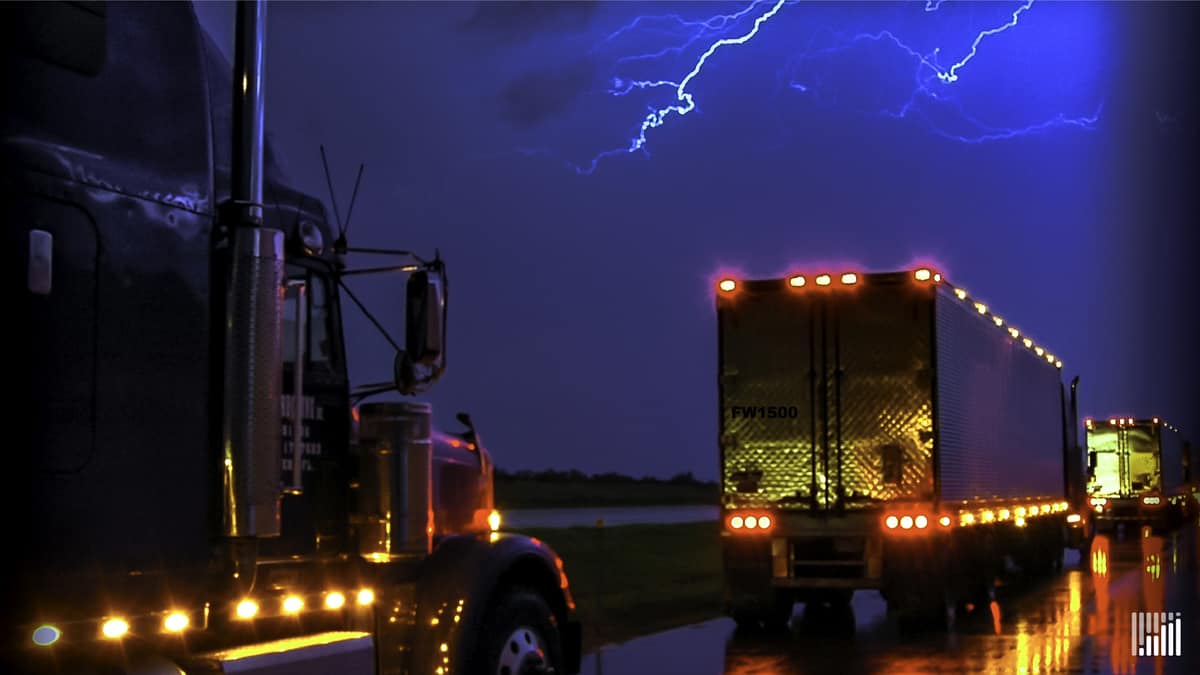Torrential, blinding rainfall can be rough on commercial truck drivers, sometimes reducing visibility to zero. But when rain leads to flooding, the danger takes on another dimension.
Flooding doesn’t only delay drivers, costing their carriers time and money, but it can also put truckers’ lives at risk.
The two types of flooding that affect drivers the most — especially long-haul and regional drivers — are river flooding and flash flooding.
River flooding
River flooding occurs when rivers overflow their banks or the edges of their main channels, inundating areas that are normally dry. River flooding can be caused by heavy rainfall, dam failures, rapid snowmelt and ice jams. It can last for days, weeks or even months. The National Weather Service (NWS) issues flood warnings for designated river forecast points where flood stages have been established.
Major river flooding in Fremont County, Iowa, March 2019. (Photo: Fremont County EMA)
River flooding is classified as minor, moderate or major. This is based on water height and impacts that have been coordinated with the NWS and local officials. Major flooding usually impacts high-traffic routes, such as interstates, and may force mass evacuations.
Flash flooding
A flash flood is caused by excessive rainfall over a short period of time, generally less than six hours. Flash floods are usually characterized by raging torrents after heavy rains rip through riverbeds, urban streets or mountain canyons. They are most common in low-lying areas, and are usually caused by thunderstorms, in addition to slow-moving fronts and tropical cyclone remnants.
Flash floods can occur within minutes or a few hours after the onset of excessive rainfall. They can also occur even if no rain has fallen, like after a levee or dam has failed or after a sudden release of water by a debris jam or ice jam.
In some cases, flash flooding may even occur well away from where heavy rain initially fell. This is especially common in the western United States, where low-lying areas may be very dry one minute, then filled with rushing water from upstream the next.
Sudden downpours can rapidly change the water levels in streams and creeks, turning small waterways into violent, raging rivers. Urban areas are especially prone to flash floods due to the large amounts of concrete and asphalt surfaces that do not allow water to penetrate easily into the soil.
Flood alerts: Watch vs. warning
When NWS forecasters expect heavy rainfall that may cause flooding or flash flooding, they issue either a watch or warning to alert the public. Here are the differences among the various alerts:
• Flash flood warning: Take action! A flash flood warning is issued when a flash flood is imminent or occurring. People in the flood-prone areas should move immediately to high ground. The NWS will be changing flash flood warnings to an impact-based format to improve public response. The NWS issues more than 4,000 flash flood warnings a year.
• Flood warning: Take action! A flood warning is issued when flooding is imminent or occurring.
• Flood watch: Be prepared. A flood watch is issued when conditions are favorable for flooding. It’s not a guarantee that flooding will occur, but it’s possible.
• Flood advisory: Be aware. A flood advisory is issued when flooding is not expected to be bad enough to issue a warning. However, it may cause significant inconvenience and could lead to situations that may threaten life and/or property if people aren’t careful.
Driving safety guidelines
If drivers enter areas that begin to flood, they should exit their trucks as quickly as possible and go to higher ground. It’s never safe to drive or walk through floodwaters. According to the NWS, flooding is the second-deadliest weather hazard in the United States each year, and half of flood-related deaths occur in vehicles. The deadliest weather hazard is extreme heat.
People often underestimate the force and power of water. According to the NWS, a mere 6 inches of fast-moving floodwater can knock over an adult. It takes just 12 inches of rushing water to carry away most cars, and just 2 feet of rushing water can carry away SUVs and trucks.
The water across a flooded road may be deeper than it looks. Drivers should never go around “Road Closed” barriers because the road may have collapsed under the water, forming a sinkhole.
Remember the NWS saying: Turn Around Don’t Drown.
